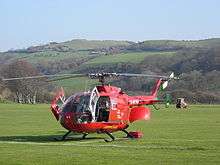Welsh Ambulance Service

The Welsh Ambulance Service, formally the Welsh Ambulance Services NHS Trust (Welsh: Ymddiriedolaeth GIG Gwasanaethau Ambiwlans Cymru), is the national ambulance service for Wales and one of the three NHS trusts in the country. It was established on 1 April 1998 and has 2,500 staff providing ambulance and related services to the 2.9 million residents of Wales.[1]
Organisation
The Welsh Ambulance Service's headquarters is located at H.M. Stanley Hospital, St Asaph, Denbighshire. The service is currently divided into three regions:
- Central and West Region – based at Ty Maes Y Gruffudd, Cefn Coed Hospital, Cockett, Swansea
- North Region – based at H.M. Stanley Hospital, St Asaph, Denbighshire
- South-East Region – based at Vantage Point House, Ty Coch Industrial Estate, Cwmbran
The service is currently investing heavily as part of a five-year modernisation plan, this will see the end of Regions and management will be via Heads of Services aligned to the Health Board areas along with a Head of Service for the Clinical Contact Centres and Head of Service for Production which oversees the resources available within the geographical areas.
Services

The Welsh Ambulance Service provides:
Emergency Medical Services (EMS) - This service responds to emergency 999 calls and GP's urgent calls. A standard crew combination for this service would normally consist of a Paramedic and an Emergency Medical Technician. However double Paramedic / double Technician crews are not uncommon. As of 2013, the majority of the EMS fleet consists of Wilker Mercedes Benz 519 Sprinter Ambulances, And Honda CRV / Ford Focus Rapid Response Vehicles.

Helicopter Emergency Medical Service (HEMS) - Wales is served by three helicopters operated by Wales Air Ambulance. The service has paramedics and helicopters stationed at Caernarfon, Welshpool and Dafen Llanelli Combined, the HEMS units are capable of reaching a critically ill patient anywhere in Wales within 20 minutes of receiving a call. Each helicopter crew consists of a pilot and two critical care Paramedics. The service is charity funded and operated by Bond Air Services but carries the Welsh ambulance service trust logo, equipment and paramedics as part of a joint operation. As of 2012, all three aircraft operated by the charity are Eurocopter EC135's
Patient Care Services (PCS) - This service deals with the planned care aspect of ambulance work. PCS staff usually provide transport between home and healthcare facilities or some inter-hospital transfers.
Urgent Care Service (UCS) - This service bridges the gap between PCS and EMS, allowing for patients to be transferred between home and hospital or hospital to hospital while meeting the advanced needs that some of these patients may have (such as oxygen administration and continuous monitoring). UCS ambulance crews may also be allocated to EMS calls at times of high demand and following clinical telephony triage by a nurse or face to face triage by Advanced Paramedic Practitioners or Paramedic Practitioners working from a Rapid Response Vehicle.
NHS Direct Wales is a 24-hour telephone and internet health advice service provided by NHS Wales to enable people to obtain advice when use of the national emergency telephone number (999 or 112) does not seem to be appropriate but there is some degree of urgency. NHS Direct Wales supports EMS Operations by providing clinically triage for "Green 3" calls that are deemed suitable. More than 45% of 999 calls have a disposition of not requiring 999 conveyance. In addition during times of escalation other calls deemed suitable are triaged. It does not replace any of the existing emergency or non-emergency medical services but complements those already existing and enables callers who might not be fully able to diagnose themselves to be directed to care of an appropriate level of urgency, including transport to hospital if the diagnosis merits that action.
Community First Responders (CFR) - CFRs are volunteers from the community trained in basic first aid, oxygen administration and the use of an Automated External Defibrillator (AED). They are used by the ambulance service mostly in rural areas to provide basic care, such as Cardio-Pulmonary Resuscitation (CPR) before an EMS crew arrives. As CFRs are usually only sent to local calls in specified communities, they often arrive before an EMS ambulance crew, even without the use of blue lights and sirens. Whilst most CFR teams are the sole responsibility of WAST, a number of teams (especially in the county of Powys) are made up of regular divisions from St John Ambulance in Wales although this does not give them any exemptions.
There are developing numbers of Advanced Paramedic (MSc aligned to the Workforce Education & Development Service Wales Framework for advanced practice) Practitioners in the service who through their extended scope of practice are working toward advancing the service their patients receive with "see and treat" and "see and refer" models of care.
In 2012 a strategic review of the service was commissioned by the Welsh Assembly Government and was conducted by Professor Siobhan McClelland and published in April 2013.[2]
See also
References
- ↑ "Home: About us". Welsh Ambulance Service. Retrieved 3 August 2014.
- ↑ "Strategic Review of Welsh Ambulance Services". Welsh Government. 25 June 2013. Retrieved 3 August 2014.
External links
| Wikimedia Commons has media related to Ambulances in Wales. |